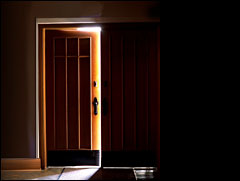Dear Umbra,
With rising heating costs on the horizon, we’re looking to install a storm door, seal gaps, etc., around the house to prevent air leaks and increase efficiency before old man winter arrives. What are some good resources (how-to’s, sustainable product suppliers, etc.) for the job?
Scott
Roswell, Ga.
Dearest Scott,
Hi-dee-ho, dee-ho, to the hardware store we go.
To choose vinyl or metal, adhesive or nails,
That will protect us from all the wintry gales.
Reading some articles on the coming storms,
Waiting to see how the caulking will perform —
Now we’ll spend a little while in the weather-stripping aisle.
It’s best at home before
To gauge windows and doors —
To figure out the yardage before spending our credit cardage.

Your comfort hinges on stripping.
Photo: iStockphoto
Well, I may be able to make it rhyme, but I can’t match the specificity and helpfulness of the instructional page on weather-stripping put out by the U.S. government’s Energy Efficiency and Renewable Energy office. Take a look.
What exactly is weather-stripping? We’ve discussed double glazing on windows, in which we put a parallel layer on the window or door with plastic sheets or storm windows; and caulking, in which we squeeze goo into spaces around the window. Weather-stripping is filling the gaps within the window or around the door with a strip of material that rebuffs the advances of cold air and moisture. It’s a good option for both homeowners and long-term renters.
Exterior doors and older windows with moving parts may leak air at closure points. Sash type windows (bottom part moves up and down) may be drafty at the top or bottom joint, within the side tracks, and at the sill. Doors may allow air through the bottom or side. From what I can tell, most weather-stripping on the market works on a compression basis. Weather-stripping on a door, for example, is placed on the jamb and compresses when the door shuts upon it, molding itself to irregularities on the door and jamb — thus ceasing air passage.
You do have quite a few choices of materials, applications, and costs, all of which are described on the EERE site in the handiest darn chart I’ve ever seen. Helpful diagrams [PDF] can also be found in Canada, home of — well, cold homes. As you think about what material to use — whether metal, vinyl, foam, or felt — you’ll want to consider weather, wear and tear, and aesthetics. Be sure to read all about vinyl, which figures prominently in weather-stripping options, before you shop. And consider this: choosing a metal variety allows you to take two important steps toward sustainability, avoiding vinyl and buying a durable product.
Honestly, you may not have much choice in materials. If my hardware store carries non-vinyl stuff, I consider myself lucky to have the option — heck, I’m lucky to get to choose between several hardware stores. But in the interests of idealism, you could spend a bit of time looking on the web for manufacturers who have been recognized for waste or emission reductions, such as in the EPA Waste Wise program, and then check for their products at your local hardware store.
You’re also lucky, because you have what looks like a very helpful enterprise right in your (relative) backyard: Atlanta’s Southface Energy and Environmental Resource Center. See what they have to say — and above all, keep warm.
Toastily,
Umbra

